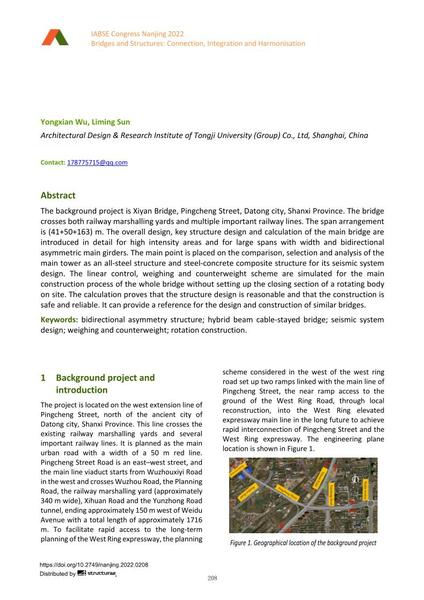Key Technology for the Design of a Cable-Stayed Bridge in a High- Intensity Area

|
|
|||||||||||
Détails bibliographiques
| Auteur(s): |
Yongxian Wu
(Architectural Design & Research Institute of Tongji University (Group) Co., Ltd, Shanghai, China)
Liming Sun (Architectural Design & Research Institute of Tongji University (Group) Co., Ltd, Shanghai, China) |
||||
|---|---|---|---|---|---|
| Médium: | papier de conférence | ||||
| Langue(s): | anglais | ||||
| Conférence: | IABSE Congress: Bridges and Structures: Connection, Integration and Harmonisation, Nanjing, People's Republic of China, 21-23 September 2022 | ||||
| Publié dans: | IABSE Congress Nanjing 2022 | ||||
|
|||||
| Page(s): | 208-215 | ||||
| Nombre total de pages (du PDF): | 8 | ||||
| DOI: | 10.2749/nanjing.2022.0208 | ||||
| Abstrait: |
The background project is Xiyan Bridge, Pingcheng Street, Datong city, Shanxi Province. The bridge crosses both railway marshalling yards and multiple important railway lines. The span arrangement is (41+50+163) m. The overall design, key structure design and calculation of the main bridge are introduced in detail for high intensity areas and for large spans with width and bidirectional asymmetric main girders. The main point is placed on the comparison, selection and analysis of the main tower as an all-steel structure and steel-concrete composite structure for its seismic system design. The linear control, weighing and counterweight scheme are simulated for the main construction process of the whole bridge without setting up the closing section of a rotating body on site. The calculation proves that the structure design is reasonable and that the construction is safe and reliable. It can provide a reference for the design and construction of similar bridges. |
||||
| Copyright: | © 2022 International Association for Bridge and Structural Engineering (IABSE) | ||||
| License: | Cette oeuvre ne peut être utilisée sans la permission de l'auteur ou détenteur des droits. |
||||
